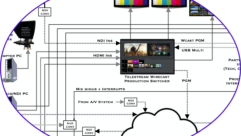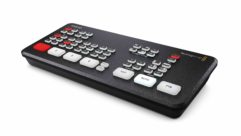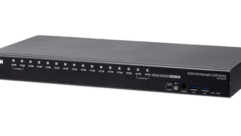COMPUTERS and their interface problems
Dec 1, 1998 12:00 PM,
Bill Whitlock
Let me start by saying that I have mixed feelings about computers. There isno doubt that they can be truly wonderful productivity tools when they workproperly, but when they fail, they quickly become a ball and chain,resulting in user frustration and unproductive downtime, unless you alwayswanted to be a computer consultant. At this point, the finger-pointing gameusually begins, and the hardware guy says it is the software and thesoftware guy says it is the hardware (or a power-line problem). It makes mewonder if automobiles would ever have become popular if their makers hadthe same relationship with gasoline providers. Anyway, my point is that thecause of a computer crash is usually a mystery to everyone involved, and areboot seems to be the universal cure.
Although I think an awful lot of software is rushed to market before it isthoroughly tested (witness the steady stream of updates to fix it), I amconvinced that many computer systems have interfacing problems seriousenough to cause many, if not most, unexplained problems. Computer users anddesigners alike seem to think that digital signals are somehow exempt fromthe laws of physics, therefore immune to ground loops and otherinterference that is routinely dealt with in analog interfaces. The onlything different about interference in digital signal interfaces is thatthere is a threshold effect. Up to this threshold level, interference hasno effect at all, but at a level ever so slightly higher, errors occur.
Ground noiseMany engineers believe that all system noise is delivered with the incomingAC power and that simply cleaning it up will solve all the noise problems.For new facilities, they will specify special, expensive “technical” powerdistribution systems using every known technique in an attempt to ward offfuture problems. For existing facilities, they may modify power wiring withno regard as to just how (or if) it will actually solve the noise problem.It seems to me that selecting an effective cure requires some knowledge ofhow and where noise is actually entering the signal path.
As I have said before, significant noise voltage will always exist betweenthe chassis grounds of any two devices operating from AC power, whether thedevices are safety grounded or not. This must be accepted as a fact oflife. This inter-chassis noise voltage is the dominant problem in mostsystems, not noise “picked up” by cables, as is so widely believed.
Power line noise current is coupled through equipment power transformersand flows in system ground conductors, creating ground noise voltages. Thisis true whether the power supply is conventional or switching or whether itis inside the equipment or outside. If power line RFI/EMI filters are usedto keep noise generated inside the equipment from getting out, they furtherincrease the noise coupling to the chassis. Because the coupling iscapacitive, high-frequency components of power line noise are coupled muchbetter than the 60 Hz line voltage itself. This “buzz-and-beyond,”high-frequency power line noise is created by power supplies in electronicequipment, fluorescent or dimmer-controlled lights and intermittent orsparking loads such as switches, relays or brush-type motors.
When this power line noise current flows in the grounded conductor of anunbalanced (single-ended) signal cable between two devices, it causes avoltage drop, which directly adds to the received signal. This results inhum and buzz in audio signals, hum bars or sparkle bands in video signals,and glitches or otherwise unexplained crashes in digital systems. Becauseof this common-impedance coupling in the ground conductor, an unbalancedinterface of any kind is simply a problem waiting to happen.
Although it is appealing to think that a big fat wire between the twochassis would short out any interfering noise voltage between them, it issimply not possible because even huge wires have a high impedance at highfrequencies due to their unavoidable inductance. To make matters worse, athigh frequencies, a building’s power wiring behaves like a system ofmisterminated transmission lines gone berserk, reflecting high-frequencyenergy back and forth throughout the building’s power wiring until it iseventually absorbed or radiated. The noise does not just follow the greenground wire back to the earth ground rod and disappear.
Power line isolation transformers, so-called balanced power, filters andconditioners presumably divert noise currents to ground. In most cases,however, there is no suitable low-impedance ground to dump the noisecurrents into (copper sheet flooring would make a wonderful ground planefor this purpose). Diverting them into the outlet’s safety ground is not agood solution. Because equipment usually ties safety ground to signalreference ground and because the building’s safety ground wiring has highimpedance (inductance again), these power-line treatments often aggravatehigh-frequency system noise problems. If, however, any of these treatmentsare installed at the service entry panel where a low-impedance earth groundis available (and star connected to the building ground system), thesetreatments can substantially eliminate ingress of external power line noise.
For the same reasons, divert the power surge or spike caused by a nearbylightning strike with a hefty MOV suppressor installed at the service entrypanel. If you feel it is necessary to protect against spikes or surgescaused by other equipment on the user side of the service entry panel, useonly a series-mode surge suppressor at the point-of-use outlet. Series-modesuppressors, such as the Surge-X line from New Frontier Electronics(www.frontierelec.com), do not dump spike currents into the outlet’s safetyground. Such dumping by widely overused shunt mode MOV suppressors cancause severe ground voltage transients between the grounds ofinterconnected equipment. Reports of computer interface boards going up inflames when a real surge actually occurs are not uncommon. Ground-relatednoise problems of some sort are virtually guaranteed once the distancebetween system devices gets large enough or multiple devices are operatedfrom different AC branch circuits. Computers and their peripherals are noexception.
Data interfacesToday, computer slots can provide analog audio and video I/O ports inaddition to data I/O, and I am amazed at how often these are unbalancedconnections. The oldest of the data transmission standards, RS-232, wasfirst used in Teletype machines at a time when electromagnetic interference(EMI) was hardly the concern it is today. It eventually migrated intocomputers and is in surprisingly widespread use today. RS-232 is anunbalanced interface where, typically, receiver thresholds for a one and azero are separated by as little as 300 mV, and response times are wellunder 1 ms.
More modern standards have tended toward smaller voltage swings and higherdata rates. A good example is RS-422, which was developed by thetelecommunications industry for short-haul modems. Perhaps its single mostimportant feature is the differential signaling technique. This was hardlya surprise because decades earlier, telephone companies recognized theimportant advantages of differential (balanced) lines at rejecting noise,but even these interfaces are not bulletproof. Although, like balancedaudio inputs, they are differential responding, typical RS-422 receiverscannot reject common-mode noise over about +/- 7 V.
I spoke recently with a fellow who does video post-production work and wasexperimenting with power-line conditioners to reduce noise. He said that hecompares the file sizes of the digitized and compressed video for theindirect measurement of noise in the source analog video. In this case, Istrongly suspect that low-level, high-frequency noise, which may be barelyvisible, is being coupled into the unbalanced video coaxial cable viacommon-impedance coupling, which is then treated by the digitizer andcompressor as fine picture detail.
GuidelinesDo not add unnecessary grounds. Additional grounding of equipment willgenerally increase circulating interference currents rather than reducethem. Of course, never disconnect or lift a safety ground or lightningprotection ground to solve a problem; the practice is both illegal anddangerous.
Keep cables as short as possible. Longer cables increase the couplingimpedance and the likelihood of interference. Serious noise coupling iscommon with 50 foot (15.2 m) or 100 foot (30.4 m) cables. Even much shortercables can produce severe problems if there are multiple grounds. Nevercoil excess cable length.
Use surge suppressors and filters carefully and sparingly. Simply puttingthem everywhere can create more problems than it solves. Choose the typeand location after sketching out signal and data flow. Power line paranoiaand the shotgun problem-solving approach may result in costly butineffective solutions.
Install signal or data line isolation devices. Isolation is the silverbullet that provides a barrier between different ground points andcompletely stops noise current flow in signal cables. It allows equipmentthat is grounded at widely separated points to exchange noise-free signals.I highly recommend them as low-cost data error insurance. TelebyteTechnology (www.telebyteusa.com) makes a wide variety of data lineisolators. Its model 268, for example, is an RS-232 opto-isolation modulethat costs about $100.
Even as expanding interconnections between audio, video, security,telephone and computer systems create more ground noise problems, mostequipment manufacturers and so-called industry experts will continue toblame bad grounding and power-line noise for the shortcomings of their I/Ointerfaces. A ray of hope is the fact that many, if not most, LAN interfacecards have built-in transformer isolation at the I/O connection.










